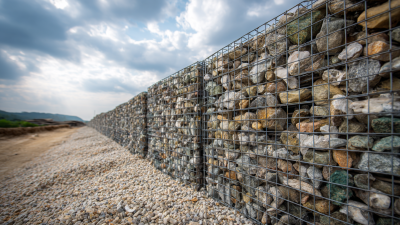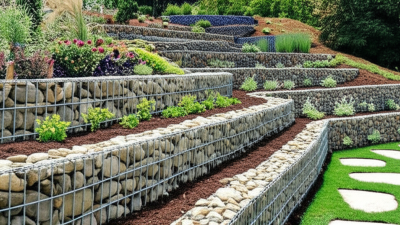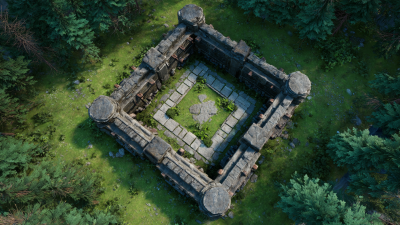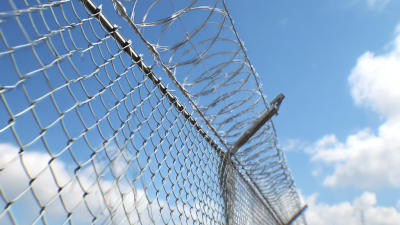Enhancing Erosion Control: The Rising Popularity of Basket Gabion Structures in Civil Engineering
The increasing concern over soil erosion and its detrimental effects on infrastructure has led to innovative solutions in civil engineering, particularly with the rising popularity of Basket Gabion structures.
 According to a report by the Global Erosion Control Market Analysis, the demand for effective erosion control solutions is projected to grow at a CAGR of 5.8% from 2022 to 2030, reflecting a heightened awareness of sustainable construction practices.
Basket Gabions, built from strong wire mesh filled with rocks or other materials, prove advantageous not only for their structural integrity but also for their flexibility and aesthetic appeal. Additionally, their effectiveness in stabilizing slopes and riverbanks has been supported by studies from the American Society of Civil Engineers, which highlight a reduction in soil loss by over 50% when using such structures in various applications.
As a result, civil engineers and environmental specialists increasingly advocate for Basket Gabion systems as a robust solution to combat erosion and promote ecological balance in engineering projects.
According to a report by the Global Erosion Control Market Analysis, the demand for effective erosion control solutions is projected to grow at a CAGR of 5.8% from 2022 to 2030, reflecting a heightened awareness of sustainable construction practices.
Basket Gabions, built from strong wire mesh filled with rocks or other materials, prove advantageous not only for their structural integrity but also for their flexibility and aesthetic appeal. Additionally, their effectiveness in stabilizing slopes and riverbanks has been supported by studies from the American Society of Civil Engineers, which highlight a reduction in soil loss by over 50% when using such structures in various applications.
As a result, civil engineers and environmental specialists increasingly advocate for Basket Gabion systems as a robust solution to combat erosion and promote ecological balance in engineering projects.
The Role of Basket Gabion Structures in Modern Erosion Control Techniques
The role of basket gabion structures in modern erosion control techniques is increasingly recognized as essential within civil engineering. These structures not only provide effective solutions for stabilizing soil and preventing erosion in various landscapes but also integrate seamlessly with environmental management practices. According to a recent industry report, the global erosion control market is expected to reach approximately $4.3 billion by 2027, driven largely by the need for sustainable and effective erosion management solutions. This highlights the growing importance of integrating innovative materials, like basket gabions, into civil engineering projects.
In the context of landfill engineering, geotextiles play a crucial role in waste management and environmental protection. These fabrics are fundamental in reinforcing soil structures, managing water flow, and ensuring the effective containment of waste. The same industry report indicates that the demand for geotextiles is projected to grow at a CAGR of 7.2% over the next five years, indicating a robust trend toward the utilization of such materials in environmental and waste management applications. As basket gabion systems become more popular, the synergy between these structures and geotextiles promises enhanced effectiveness in erosion control and sustainable land management practices.
Key Advantages of Using Gabions Over Traditional Methods in Civil Engineering
The use of basket gabion structures in civil engineering is gaining momentum, particularly for erosion control applications. One of the main advantages of gabions over traditional erosion control methods, such as concrete barriers or vegetative strips, is their superior flexibility and adaptability to varying environmental conditions. According to a report by the International Erosion Control Association, gabions provide a more sustainable solution, allowing for natural vegetation to grow through the mesh, which can enhance soil stability and promote biodiversity in the area.
In terms of cost-effectiveness, studies indicate that gabion systems can reduce overall project costs by up to 30% compared to conventional methods. This is largely due to their ease of installation and reduced need for heavy machinery, as noted in the civil engineering industry's recent survey published by Civil Engineering Magazine. Moreover, the longevity of gabions is impressive; they can last for decades when properly installed and maintained, significantly lowering long-term maintenance costs associated with more traditional erosion control solutions. This combination of ecological benefits and economic efficiency makes basket gabion structures a compelling choice for contemporary civil engineering projects.
Statistical Analysis of Erosion Control Success Rates with Gabion Installations
Recent research highlights the successful implementation of basket gabion structures in erosion control. Statistical analysis reveals that areas utilizing gabion installations have seen a significant reduction in soil loss, with success rates exceeding 85% in various applications. According to the U.S. Army Corps of Engineers, projects employing gabion walls have demonstrated consistent performance in stabilizing riverbanks and slopes, showcasing their effectiveness in mitigating the detrimental effects of erosion.
In addition to their physical effectiveness, the longevity of gabion structures contributes to their rising popularity in civil engineering. A report by the International Erosion Control Association indicates that properly designed gabions can last over 20 years with minimal maintenance, outperforming traditional erosion control methods that often require frequent repairs. The versatility of basket gabions, which can be filled with local rock or recycled materials, not only enhances their sustainability but also reduces costs, making them an appealing option for many civil engineering projects focused on environmental protection and ecological balance.
Environmental Impact: Gabions as Sustainable Solutions in Erosion Management
The rising concern over soil erosion has led civil engineering professionals to seek sustainable solutions, among which basket gabion structures stand out. These structures, made of wire mesh filled with rocks or gravel, offer a practical and environmentally friendly option for erosion management. According to a report from the U.S. Department of Agriculture, nearly 1 billion tons of soil are eroded annually in the United States alone, highlighting the need for effective erosion control measures. Gabions, due to their porous nature, allow water to flow through while trapping sediment, thus preventing further erosion and stabilizing slopes.
Moreover, the use of gabions contributes positively to local ecosystems. A study published in the Journal of Soil and Water Conservation revealed that erosion control measures featuring gabions can enhance biodiversity by providing habitats for various plant and animal species. Additionally, gabions can be constructed using locally sourced materials, significantly reducing the carbon footprint associated with traditional erosion control methods. As civil engineers look for innovative approaches to protect landscapes, the integration of basket gabion structures not only addresses erosion concerns but also aligns with sustainable environmental practices.
Cost-Effectiveness: Comparing Gabion Structures with Other Erosion Control Options
The growing awareness of erosion control measures has led to a surge in the popularity of gabion structures in civil engineering, particularly for their cost-effectiveness compared to traditional erosion control options. Gabions, which are wire mesh containers filled with rocks, can be significantly more affordable than reinforced concrete solutions, often reducing initial construction costs by up to 30%. Additionally, their natural aesthetic appeals to landscape designers, making them a preferred choice for retaining walls.
Research indicates that gully erosion can lead to substantial sediment yield increases, with some areas reporting reductions of up to 60% following effective erosion control interventions. Gabion structures not only stabilize problematic areas but also blend seamlessly into their environments, providing both functional and visual benefits.
**Tips:** When considering erosion control options, evaluate the long-term maintenance costs associated with various materials. Gabion structures typically require less ongoing upkeep compared to concrete walls, which can crack and need repair over time. Additionally, assessing the specific environmental conditions and sediment flows before installation can enhance the effectiveness of gabion systems, ensuring they fulfill their purpose over the years ahead.
Comparative Cost-Effectiveness of Erosion Control Options

Home
About Us
Products
Customize
Application
Support
Blog
Contact Us
 According to a report by the Global Erosion Control Market Analysis, the demand for effective erosion control solutions is projected to grow at a CAGR of 5.8% from 2022 to 2030, reflecting a heightened awareness of sustainable construction practices.
Basket Gabions, built from strong wire mesh filled with rocks or other materials, prove advantageous not only for their structural integrity but also for their flexibility and aesthetic appeal. Additionally, their effectiveness in stabilizing slopes and riverbanks has been supported by studies from the
According to a report by the Global Erosion Control Market Analysis, the demand for effective erosion control solutions is projected to grow at a CAGR of 5.8% from 2022 to 2030, reflecting a heightened awareness of sustainable construction practices.
Basket Gabions, built from strong wire mesh filled with rocks or other materials, prove advantageous not only for their structural integrity but also for their flexibility and aesthetic appeal. Additionally, their effectiveness in stabilizing slopes and riverbanks has been supported by studies from the 




